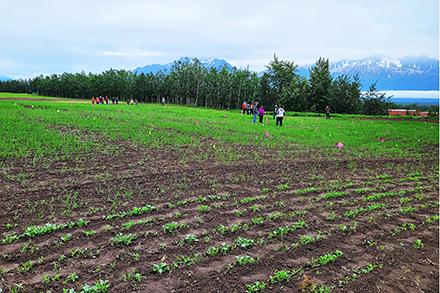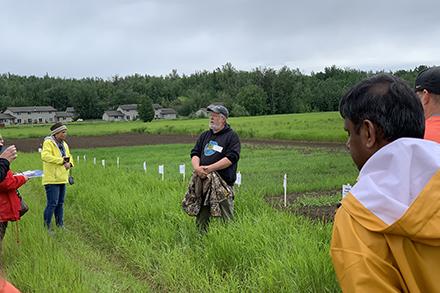Northern Exposure

ARS and University collaborators inspect research plots at the Matanuska Experiment Farm and Extension Center in Palmer, AK. (Photo by David Archer, ARS)
Few regions of the U.S. exhibit the interaction of climate change and agriculture as dramatically as Alaska, where the growing season keeps getting longer, and parts of the landscape are pockmarked by holes, the ghosts of missing permafrost. To help farmers figure out how to approach this changing terrain, a team of ARS researchers based in Mandan and Fargo, ND, are collaborating with colleagues from the University of Alaska Fairbanks on a set of projects focused on Alaskan agriculture. Their goal is to ensure that Alaska farmers have the best possible crops and practices for resilient and sustainable production in their changing conditions. David Archer, a research leader at the Northern Great Plains Research Laboratory in Mandan, ND, heads the USDA part of the initiative, and is joined by fellow ARS researchers John Hendrickson, Claire Friedrichsen, James Anderson and Jinita Sthapit.
The projects are wide-ranging as the team explores a number of different questions – including which questions to explore.
“Our collaborative research with UAF is being driven by stakeholders and is supporting Alaska’s goal of increasing food security,” said Friedrichsen, whose work focuses on the human dimensions of soil science and food security. She is one of the first three social scientists hired at ARS as part of a new capacity-building initiative.
Some of the questions that have arisen so far include which crops might grow well in Alaska’s changing conditions, how to breed new varieties that are better-suited and more productive in those conditions, as well as how emerging technology might pair with some of the goals that Alaskans have.

A group listens as University of Alaska researcher Robert Van Veldhuizen discusses ongoing work on the experimental plots in Palmer, Alaska. (Photo by John Hendrickson/ARS).
The research efforts include studying grasses, legumes and oilseed crops, such as sainfoin, yellow-flowered alfalfa, camelina, and sunflower. The team is exploring whether, or how well, crops they study in North Dakota might grow in Alaska. The research in Alaska encompasses areas with multiple, different climatic conditions, from cool and moist areas in which forages would be expected to thrive, to areas with warmer and drier summers, where annual crops might do well. In some cases, the researchers expect that certain crops might even fare better in Alaska. The Alaskan researchers are also taking advantage of the extended growing season by breeding new barley, oat, and spring wheat varieties that are suited to the new conditions.
More broadly, stakeholders have expressed interest in economic development and greater food security through local production, a goal that arises naturally from a long-standing commitment to self-sufficiency in Alaska. As more land comes into agricultural production, Archer said, “we want to be ahead of the curve and understand what can be grown where, to understand the sustainability aspect of that, helping to ensure that increase happens in a way that doesn’t degrade the soils and is sustainable long-term.”

